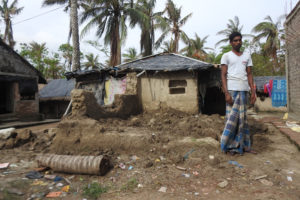On May 7 this year, a gas leak at an LG Polymers chemical plant in Andhra Pradesh brought back gut-wrenching memories of the Bhopal tragedy. Twelve people died and 350 were injured in the accident.
The Covid-19 pandemic and national lockdown meant that production facilities across the country had to close immediately. Without adequate protocols in place, a hasty shutdown increased the risk of industrial disasters. Calamities like the gas leak make painfully obvious the deficiencies in India’s environmental regimes. These shortcomings are writ large in the 2020 draft Environmental Impact Assessment (EIA) notification.
Contextualising the EIA
Deemed a “global symbol of neoliberal environmental regulation”, the EIA aims to integrate environmental protection into development projects. First introduced in the United States, the practice of an EIA grew out of an era of landmark environmental legislation in the 1970s. The United Nations later officially recognised the EIA under Principle 17 of the Rio Declaration, and today more than 100 countries have adopted the EIA process.
In India, the EIA took effect in 1994 and was revamped in 2006. Viewed as a cornerstone of environmental jurisprudence, the EIA is a bulwark against wholesale ecological destruction. However, over the years the Ministry of Environment, Forest and Climate Change (MoEFCC) has severely watered down the EIA process – a trend that has only been catapulted forward under the current administration’s utmost good faith doctrine, which permits industries to self-report their environmental impacts. This ‘race to the bottom’ forms the backdrop of the draft EIA.
2020 draft EIA
The proposed notification ostensibly seeks to enhance transparency. Critics, on the other hand, contend that the draft erodes the substantive and procedural foundations of the EIA. Two slated changes have in particular received intense backlash: post facto clearance of projects and dilution of public consultation. Regarding the former, projects that were operating without prior clearance can receive post facto approval from the regulatory body once the project proponent pays the stipulated fine. In terms of public participation, the draft exempts a slew of projects from public hearing. If these sweeping amendments are actually carried out, India is poised to witness more tragedies on the scale of Bhopal, warned Leo Saldanha, coordinator of the Environment Support Group.
EIA design and structure
While the draft EIA has generated significant controversy, it stems from a broader EIA regime that has proved to be unwieldy. Re-engineered once and amended several times, the EIA is often described as a “thorn in the flesh of both industry and environmentalists”.
EIA mechanisms can, however, be effective when implemented successfully. Having emerged out of an age of rational planning in the 1960s and 70s, the EIA follows a techno-rationalist model of decision-making. This apparatus incorporates public participation, which renders development planning a more community-centred process.
And yet, the EIA falls short of capturing the full scale of India’s environmental challenges. At a time when pollution levels are skyrocketing, groundwater is rapidly depleting and rivers are turning into streams of sewage and effluent, industries must play a greater role in circumventing an ecological crisis. But India’s EIA architecture is primarily geared towards mitigation; it does not actively incentivise sustainable development.
See: Opinion: India must go green or perish
Obstacles to implementation
In theory, the EIA is a relatively sound piece of legislation, but a poor regulatory environment hinders implementation. For one, the regulatory body provides environmental clearance based on the recommendations of Expert Appraisal Committees (EACs). These bodies are notoriously disorganised. During the pandemic period, for example, some virtual EAC meetings have lasted less than 10 minutes.
Insufficient funding drives this mismanagement in part. Budget allocation indicates where the government’s priorities lie, said Saldanha. For the 2019-20 fiscal year the MoEFCC’s budget increased by 10%. In contrast, the coal ministry’s budget shot up by 48%.
More significantly, inaccurate reporting impedes the EACs’ functioning. Project applicants typically hire their own consultants to prepare EIA reports. Due to vested interests, these reports are often riddled with errors and omissions. For this reason, observers have declared the EIA a “project justification” rather than a project evaluation mechanism and a “decision-aiding” as opposed to a decision-making tool.
Reflections and future directions
These challenges arise out of problems plaguing environmental governance. Overarching environmental governance systems in India need restructuring.
For one, decision-makers should centre community voices at every stage of project planning. Currently, public participation exists as a single, standalone component. In addition, environmentalists have long agitated for decentralised environmental governance. To build capacity at the local level, more resources and technical expertise could be directed to panchayats and municipalities, which may be better positioned to represent community voices. With a larger environmental ministry budget, EACs could also be better resourced to oversee the preparation of EIA reports, thereby preventing the EIA from getting entangled with third-party interests.
Ultimately, a radical reimagining of progress may fuel this revamping of environmental regulation. In a country where the top 10% possesses 70% of total national wealth and upwards of 600 million people are projected to experience climate change impacts, sustainable, holistic and inclusive growth is the need of the hour.








![Indu Devi, 35, of Chapar village of Moinuddinagar block in Samastipur district of Bihar. She is suffering from lesions on her hands and feet but she never bothered to find out how they appeared. She said these don't itch, so she didn't think they need to be treated [image by: Umesh Kumar Ray]](https://dialogue.earth/content/uploads/2020/10/Indu-Devi-35-of-Chapar-village-of-Moinuddinagar-block-in-Samastipur-district-of-Bihar.-Credits-Umesh-Kumar-Ray-300x225.jpg)